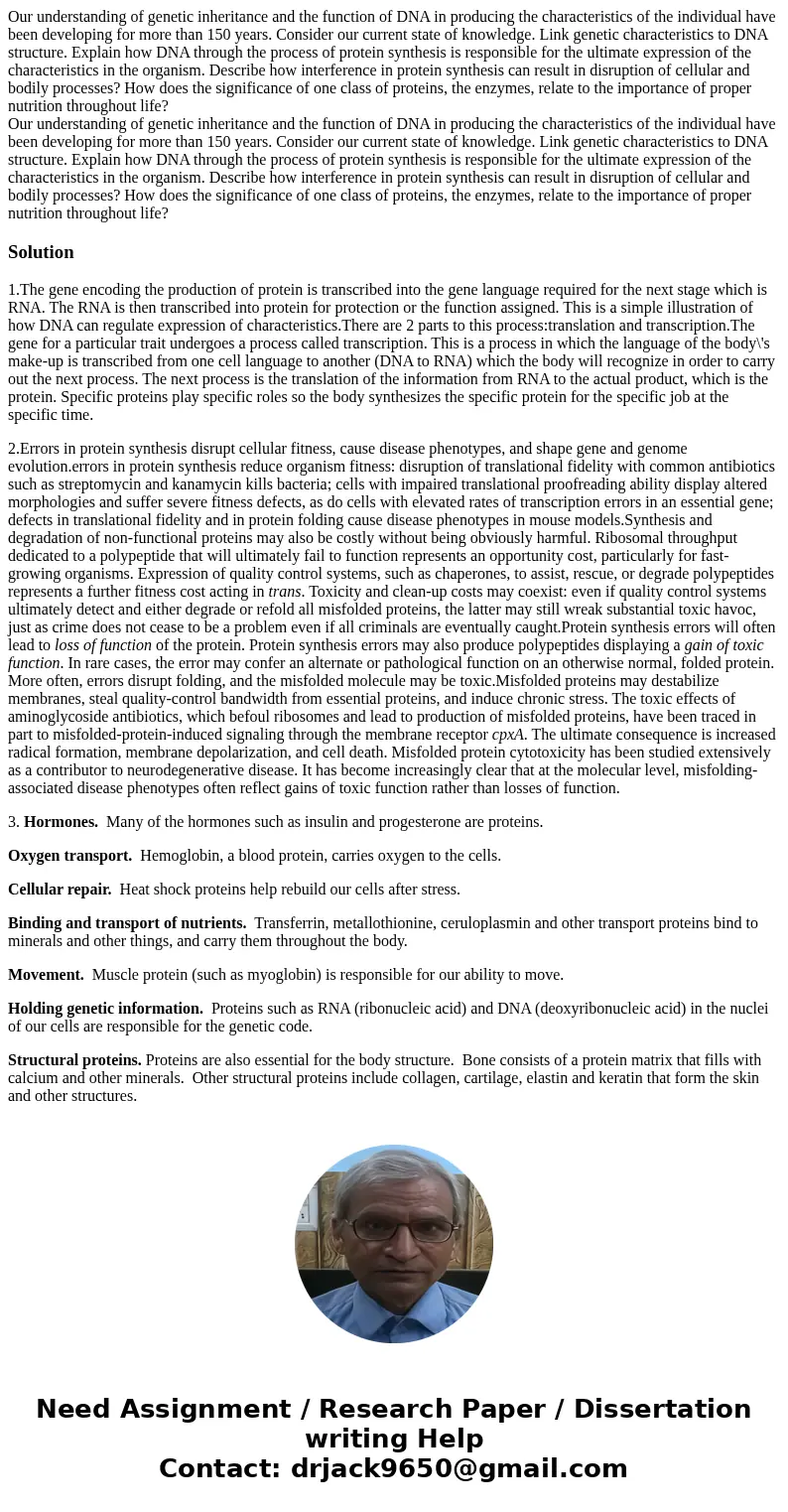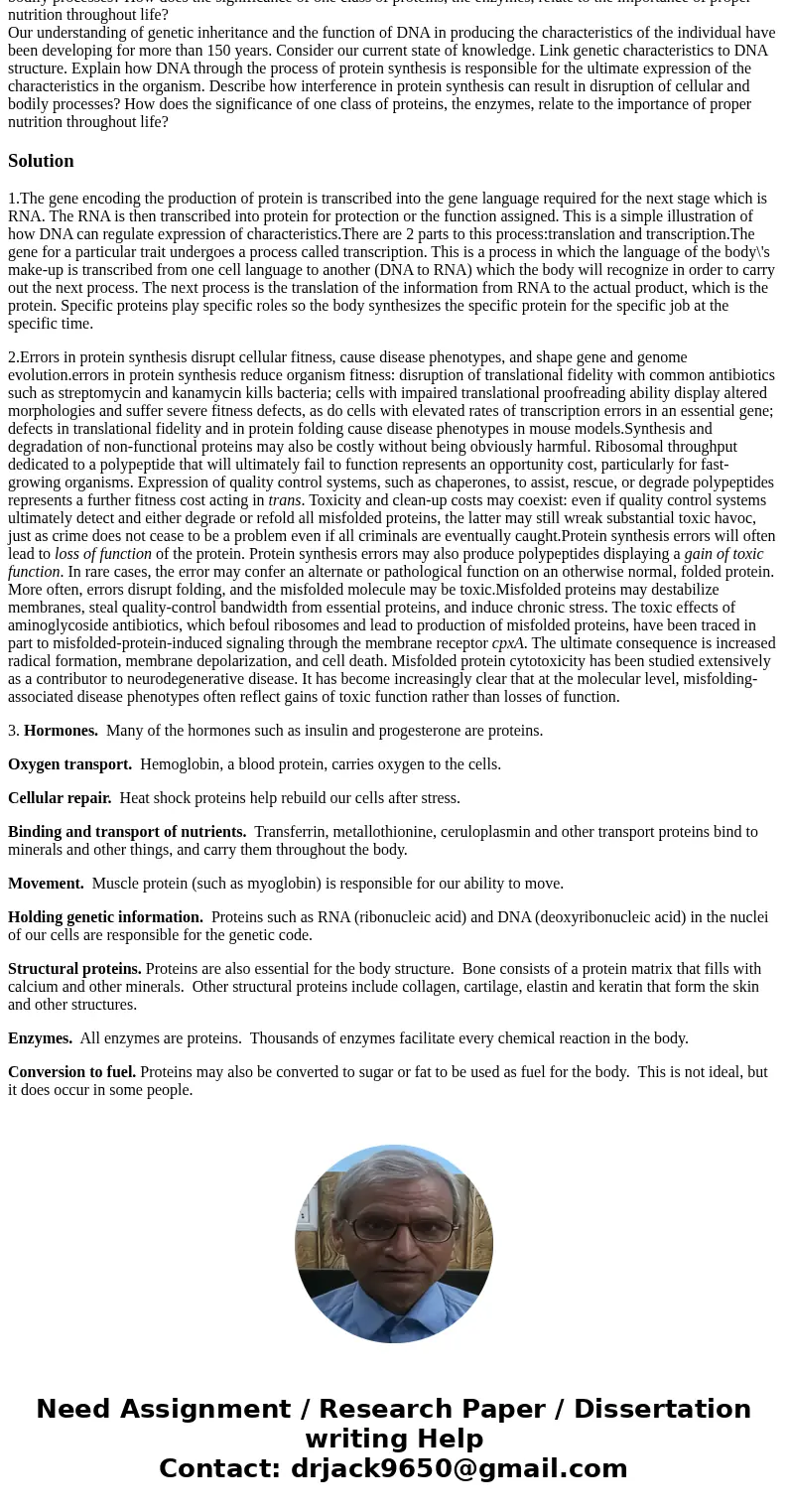Our understanding of genetic inheritance and the function of
Solution
1.The gene encoding the production of protein is transcribed into the gene language required for the next stage which is RNA. The RNA is then transcribed into protein for protection or the function assigned. This is a simple illustration of how DNA can regulate expression of characteristics.There are 2 parts to this process:translation and transcription.The gene for a particular trait undergoes a process called transcription. This is a process in which the language of the body\'s make-up is transcribed from one cell language to another (DNA to RNA) which the body will recognize in order to carry out the next process. The next process is the translation of the information from RNA to the actual product, which is the protein. Specific proteins play specific roles so the body synthesizes the specific protein for the specific job at the specific time.
2.Errors in protein synthesis disrupt cellular fitness, cause disease phenotypes, and shape gene and genome evolution.errors in protein synthesis reduce organism fitness: disruption of translational fidelity with common antibiotics such as streptomycin and kanamycin kills bacteria; cells with impaired translational proofreading ability display altered morphologies and suffer severe fitness defects, as do cells with elevated rates of transcription errors in an essential gene; defects in translational fidelity and in protein folding cause disease phenotypes in mouse models.Synthesis and degradation of non-functional proteins may also be costly without being obviously harmful. Ribosomal throughput dedicated to a polypeptide that will ultimately fail to function represents an opportunity cost, particularly for fast-growing organisms. Expression of quality control systems, such as chaperones, to assist, rescue, or degrade polypeptides represents a further fitness cost acting in trans. Toxicity and clean-up costs may coexist: even if quality control systems ultimately detect and either degrade or refold all misfolded proteins, the latter may still wreak substantial toxic havoc, just as crime does not cease to be a problem even if all criminals are eventually caught.Protein synthesis errors will often lead to loss of function of the protein. Protein synthesis errors may also produce polypeptides displaying a gain of toxic function. In rare cases, the error may confer an alternate or pathological function on an otherwise normal, folded protein. More often, errors disrupt folding, and the misfolded molecule may be toxic.Misfolded proteins may destabilize membranes, steal quality-control bandwidth from essential proteins, and induce chronic stress. The toxic effects of aminoglycoside antibiotics, which befoul ribosomes and lead to production of misfolded proteins, have been traced in part to misfolded-protein-induced signaling through the membrane receptor cpxA. The ultimate consequence is increased radical formation, membrane depolarization, and cell death. Misfolded protein cytotoxicity has been studied extensively as a contributor to neurodegenerative disease. It has become increasingly clear that at the molecular level, misfolding-associated disease phenotypes often reflect gains of toxic function rather than losses of function.
3. Hormones. Many of the hormones such as insulin and progesterone are proteins.
Oxygen transport. Hemoglobin, a blood protein, carries oxygen to the cells.
Cellular repair. Heat shock proteins help rebuild our cells after stress.
Binding and transport of nutrients. Transferrin, metallothionine, ceruloplasmin and other transport proteins bind to minerals and other things, and carry them throughout the body.
Movement. Muscle protein (such as myoglobin) is responsible for our ability to move.
Holding genetic information. Proteins such as RNA (ribonucleic acid) and DNA (deoxyribonucleic acid) in the nuclei of our cells are responsible for the genetic code.
Structural proteins. Proteins are also essential for the body structure. Bone consists of a protein matrix that fills with calcium and other minerals. Other structural proteins include collagen, cartilage, elastin and keratin that form the skin and other structures.
Enzymes. All enzymes are proteins. Thousands of enzymes facilitate every chemical reaction in the body.
Conversion to fuel. Proteins may also be converted to sugar or fat to be used as fuel for the body. This is not ideal, but it does occur in some people.


 Homework Sourse
Homework Sourse